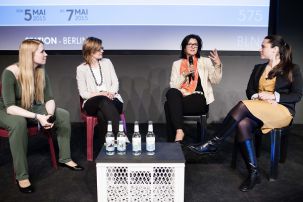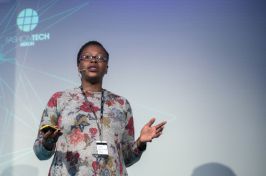The re:think mobility track by our partner Daimler made way for a wide range of different approaches. An eclectic mixture of sessions highlighted various issues specifically connected to mobility, such as language and facial expression recognition as future tools for vehicle design and controls. An additional issue was the question of women in corporate management.
Steffanie Soehnchen and Rob Dawson tackled the question of the future of mobility by asking how we want to live, and more specifically, move about in the future. The Move Forward initiative was founded to address the underlying social issues here – a project that aims to pay attention to all the different interests and demands of all stakeholders involved, regardless of brand or product. The way Steffanie Soehnchen described the process is quite self-critical, and the public is invited to participate in the challenge. What she has learned so far from the project is that in order to tap into the creativity of the masses, you are sometimes forced to question your own ideas and let them go. A notable feature of the website is the "I believe" button used instead of the more generic "I like".

Alexander Mankowsky presenting the research model ‘F 015 Luxury in Motion’. In terms of road traffic safety, close communications between autonomous cars and their drivers will become ever more important in future; credit: re:publica/Gregor Fischer (CC BY-SA 2.0)
And the most entertaining part of re:think mobility was clearly the car named Otto, featured in "Unexpected Journeys – My travels, my tyres". This unusual vehicle shows just how durable auto mechanics can be, and probably has even more stories to tell than KITT. Luckily Otto was given a voice by Gunther Holtorf, who told of his own experiences with the car. Initially the old Mercedes offroader (88 hp, built in 1988) was only meant to travel from Germany to South Africa. This turned into a 26-year journey through the entire world, covering a distance of 900,000 kilometres – which is about 22 times round the equator. But the odometer only reached up to 99,999, so occasionally an additional number would be stuck to the front of the sequence. Interestingly, Otto is also the only foreign car that has ever been permitted to enter North Korea. And now this remarkably resilient vehicle is on tour yet again, and will be travelling the world as a moving museum piece for the next two years.
An unusual compilation of thoughts on the "Possibilities for using speech and gesture recognition for the future of mobility" included a part by Philipp Wex, where he presented his ideas on the development of smart voice control systems for cars. His general conclusion: mobility increases complexity. For instance, a recorded sentence that gives road directions will sound completely different in the studio than in a fast-moving car. Background noise has to be taken into account, and the calculations adjusted accordingly. In the following part Vanessa van Edwards spoke about ongoing research into body language and facial expressions in particular. She shared some of her insights into how tiny changes in expression are indicative of certain moods or reactions. An intriguing open question is how this kind of research can be put to use for the automotive industry in future. And as finale, the mute performer Mathias Schaefer staged an impressive show. In an artistic blend of expressions and sign language, he let the audience participate in his vision of the future city.
 Philipp Wex talks about speech and gesture recognition; credit: re:publica/Gregor Fischer (CC BY-SA 2.0)Philipp Wex talks about speech and gesture recognition; credit: re:publica/Gregor Fischer (CC BY-SA 2.0)
Philipp Wex talks about speech and gesture recognition; credit: re:publica/Gregor Fischer (CC BY-SA 2.0)Philipp Wex talks about speech and gesture recognition; credit: re:publica/Gregor Fischer (CC BY-SA 2.0)
Sanja Stankovic (Digital Media Women), Kathrin Mahler Walther (Executive Director EAF Berlin), and Regina Mehler (Women Speaker Foundation) hosted the discussion on Female Leadership. All three were convinced and hopeful that in the next few years, companies that are unable to diversify will fall behind the success of others and may not persist in the long run. This will be achieved quite naturally when male and female workers who favour gender-balanced corporate management just turn their backs on the diehards.
photo credit top image: credit: re:publica/Gregor Fischer (CC BY-SA 2.0)





